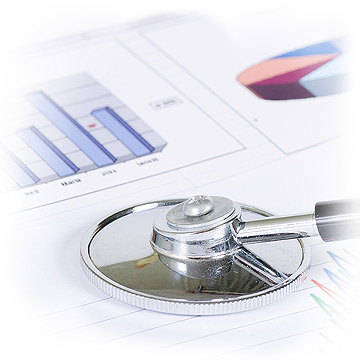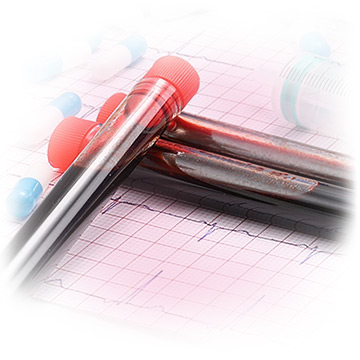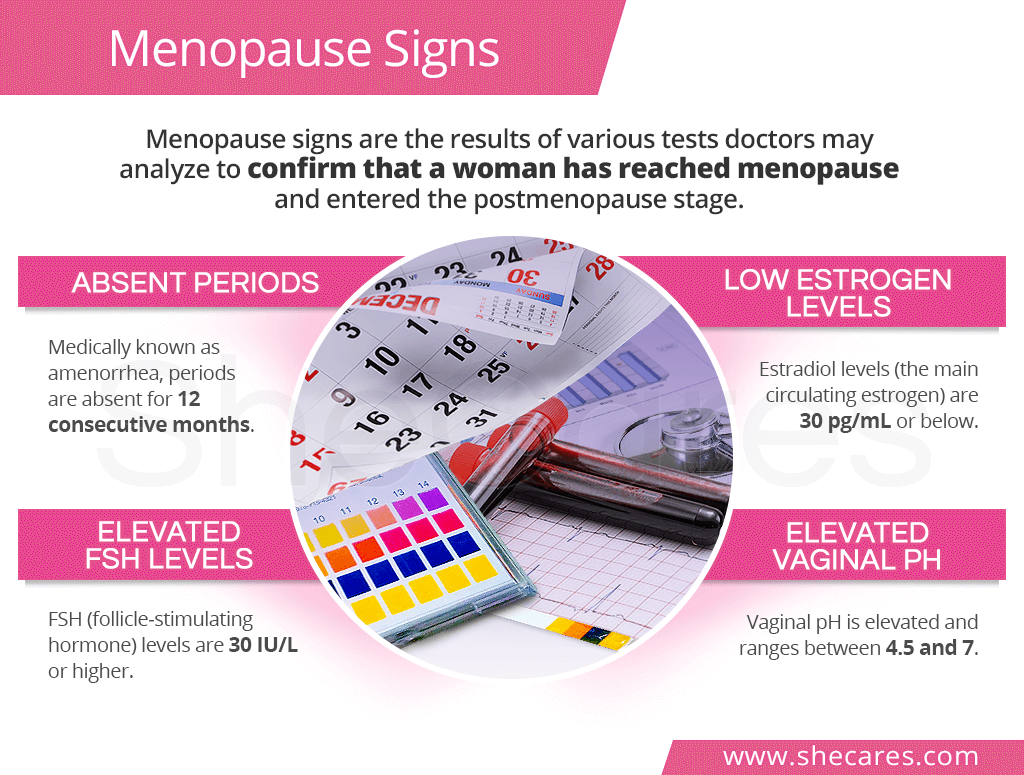Amenorrhea

Amenorrhea, a medical term for absent periods, is a principal menopause sign. To confirm menopause, a woman must not have her menses for 12 consecutive months.1
Before that, it is very common for women to experience irregular periods, including heavier flow and skipped periods. Such menstrual abnormalities are caused by depleting ovarian reserve, which deregulates the levels of reproductive hormones that govern the menstrual cycle.
Low Estrogen Levels

Once a woman did not have her periods for a year, a doctor may check her estrogen concentrations in the blood. Estradiol levels (the main circulating estrogen) of 30 pg/mL and below is a reliable menopause sign.2
Estrogen is mainly produced by the ovarian eggs, a number of which is gradually decreasing throughout women's lifetimes. By mid-40s, ovarian eggs are at near depletion, causing massive shifts in estrogen levels. Once ovaries have no more eggs, estrogen levels drop drastically and continue to be low for the rest of women's lives.
High FSH Levels

Another menopause sign that may be used to confirm the end of a woman's reproductive years is elevated FSH, or follicle-stimulating hormone, of 30 IU/L or higher.3
On a monthly basis, FSH stimulates the follicles (sacs containing ovarian eggs) to mature and start producing estrogen. By the time a woman reaches menopause, there are no follicles left in the ovaries. As such, FSH levels increase as there is not enough estrogen being produced to counteract it.
Elevated Vaginal pH

The arrival of menopause can also be confirmed by measuring vaginal pH, which increases in postmenopausal women above 4.5 (most commonly ranging between 4.5 and 6).4
During the reproductive years, vaginal pH stays in a moderately acidic range (below 4.5) to prevent infections. Due to low postmenopausal estrogen, the pH in the vagina increases, becoming less acidic. Levels above 4.5 can be treated as a sign of menopause, as long as a woman does not currently have a vaginal infection.
Additional Menopause Signs
Besides the aforementioned four menopause signs, there might be others women may come across as they research more about the transition.
This may include salivary hormone levels, which are not considered a reliable menopause sign as they can be affected by a variety of factors.
Additionally, some postmenopausal women may also have their bone mineral density measured. While undergoing regular bone density tests is essential for maintaining good postmenopausal health, it is mainly used to rule out or diagnose osteoporosis, not menopause per se.
Key Takeaways
It is worth keeping in mind that there is usually no need to obtain all of the aforementioned menopause signs. A woman's age, experienced symptoms, and the cessation of menstrual periods are usually enough to confirm that she has reached menopause and enters the postmenopause stage. Nevertheless, doctors may still look for other signs of postmenopause, such as low estrogen levels, high follicle-stimulating hormone levels, and elevated vaginal pH. Confirming the arrival of menopause is important for ensuring adequate care and optimal health of women throughout their postmenopausal years, including reducing the associated health risks of that life stage.
Sources
- BreastCancer.org. (2020). Tests to Determine Menopausal Status. Retrieved March 22, 2021 from https://www.breastcancer.org/tips/menopausal/types/determine-status
- Endocrinology and Metabolism Clinics of North America. (2020). Endocrinology of the Menopause. Retrieved March 22, 2021 from https://www.ncbi.nlm.nih.gov/pmc/articles/PMC6983294/
- Medline Plus. (2020). Follicle-Stimulating Hormone (FSH) Levels Test. Retrieved March 22, 2021 from https://medlineplus.gov/lab-tests/follicle-stimulating-hormone-fsh-levels-test/
- Menopause. (2020). Baseline estrogen levels in postmenopausal women participating in the MAP.3 breast cancer chemoprevention trial. Retrieved March 22, 2021 from https://www.ncbi.nlm.nih.gov/pmc/articles/PMC7469568/
- Menopause. (2018). Vaginal pH: a simple assessment highly correlated with vaginal morphology and symptoms in postmenopausal women. Retrieved March 22, 2021 from https://journals.lww.com/menopausejournal/Abstract/2018/07000/Vaginal_pH__a_simple_assessment_highly_correlated.9.aspx
- Saudi Medical Journal. (2010). Can vaginal pH predict menopause? Retrieved March 22, 2021 from https://pubmed.ncbi.nlm.nih.gov/20231928/
- The North American Menopause Society. (n.d.). Changes in Hormone Levels. Retrieved March 22, 2021 from https://www.menopause.org/for-women/sexual-health-menopause-online/changes-at-midlife/changes-in-hormone-levels
- University of Rochester Medical Center. (n.d.). Follicle-Stimulating Hormone. Retrieved March 22, 2021 from https://www.urmc.rochester.edu/encyclopedia/content.aspx?contenttypeid=167&contentid=follicle_stimulating_hormone
Footnotes:
- The North American Menopause Society. (n.d.). Overview of Menopause. Retrieved March 22, 2021 from https://www.menopause.org/publications/clinical-care-recommendations/chapter-1-menopause
- University of Rochester Medical Center. (n.d.). Estradiol (Blood). Retrieved March 22, 2021 from https://www.urmc.rochester.edu/encyclopedia/content.aspx?ContentTypeID=167&ContentID=estradiol
- The North American Menopause Society. (n.d.). How Do I Know When I'm in Menopause? Retrieved March 22, 2021 from https://www.menopause.org/for-women/menopauseflashes/menopause-symptoms-and-treatments/how-do-i-know-when-i%27m-in-menopause-
- Journal of Mid-Life Health. (2014). Vaginal pH: A marker for menopause. Retrieved March 22, 2021 from https://www.ncbi.nlm.nih.gov/pmc/articles/PMC3955044/
